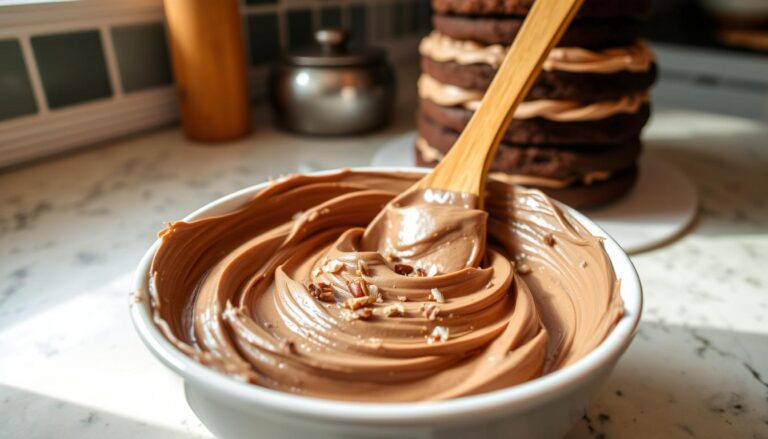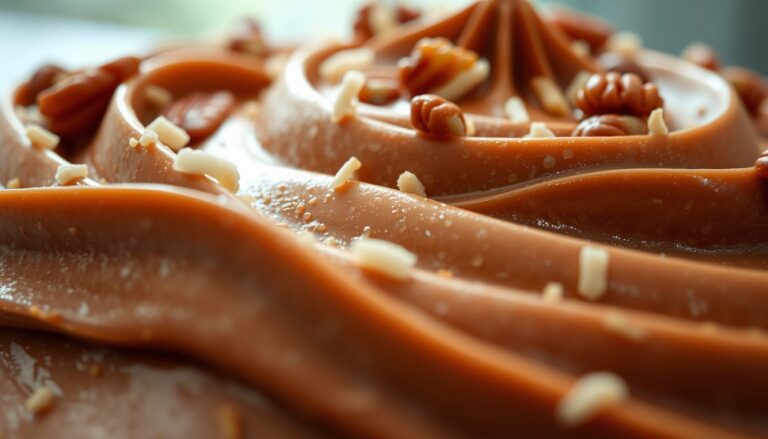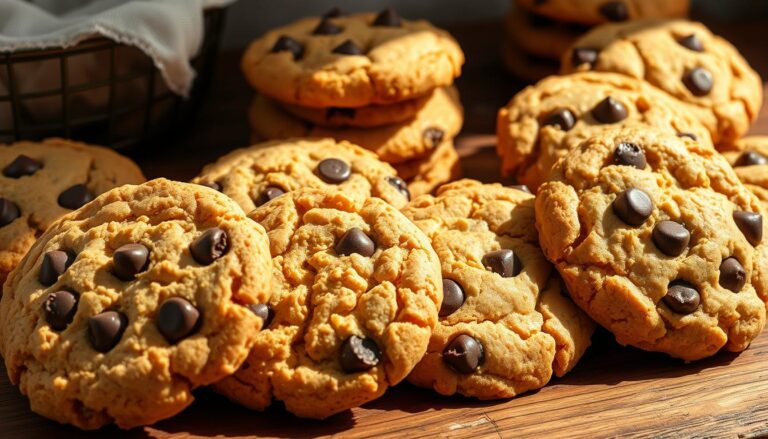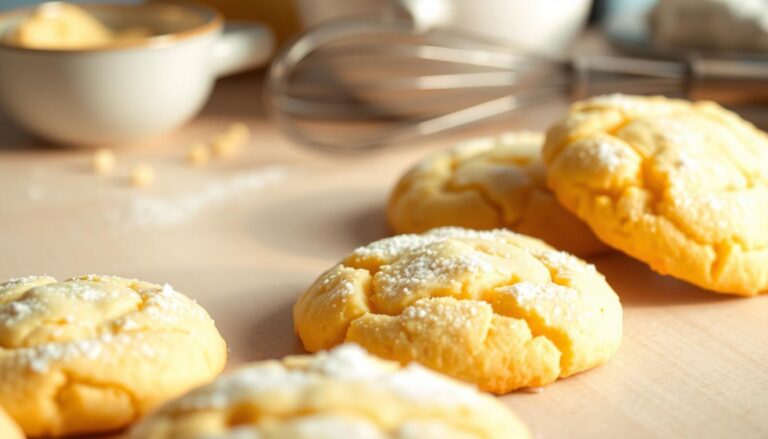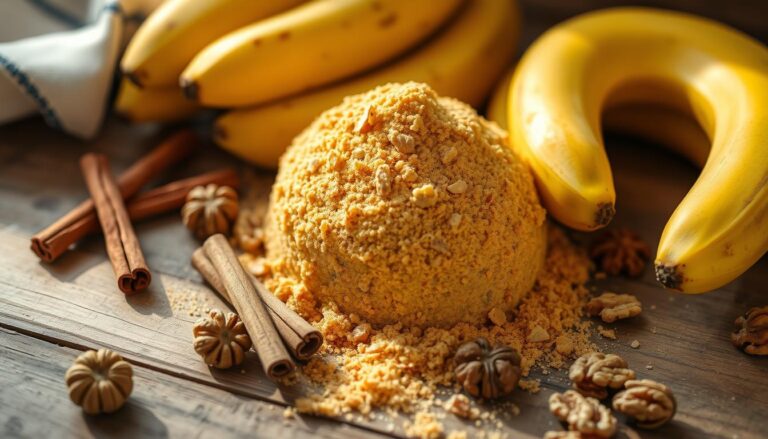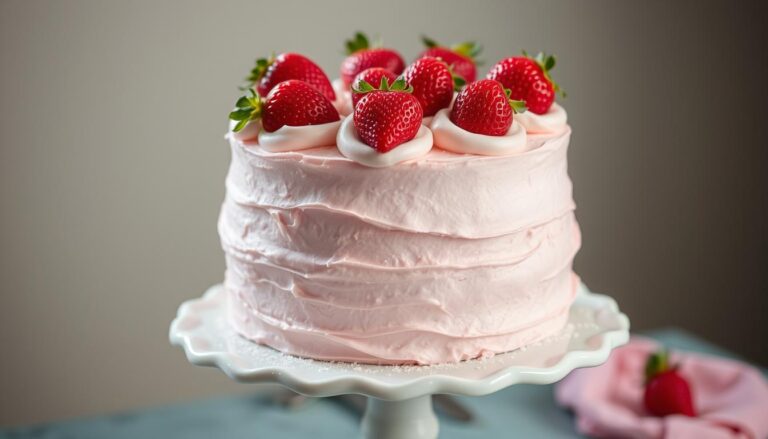Madeleine Cookie Recipe: Delicious French Treat
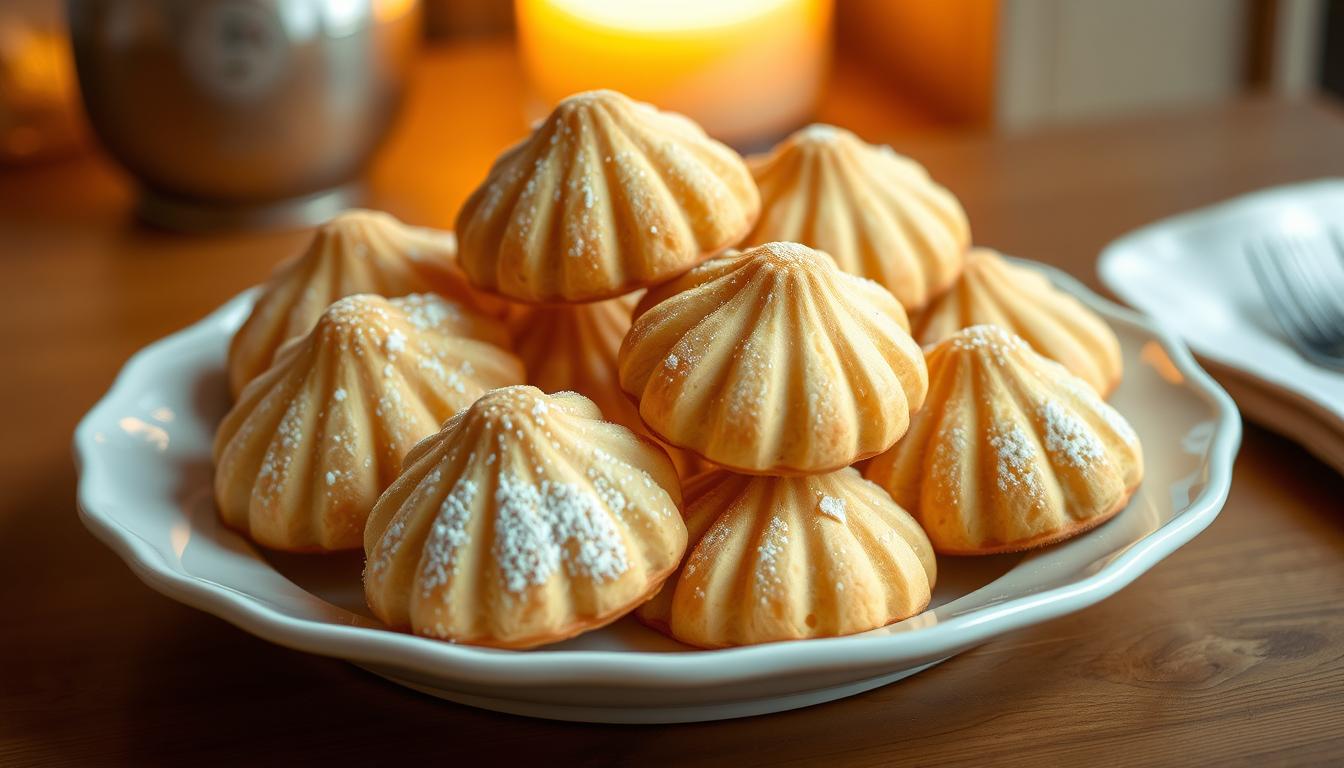
Every time I smell a freshly baked madeleine cookie, I’m taken back to a small French bakery in Paris. It was there I first found these magical treats. The golden, shell-shaped cookie melts in your mouth, bringing centuries of tradition.
Your journey to making an authentic madeleine cookie recipe begins here. It’s a delightful adventure that will improve your baking skills and taste buds.
Madeleines are more than just cookies; they’re a sensory experience that connects you to French pastry heritage. This recipe will guide you in making these delicate sponge cakes. They are tender, light, and rich with buttery flavor.
Whether you’re new to baking or experienced, mastering madeleines will take your baking to the next level.
Table of Contents
Key Takeaways
- Madeleines are traditional French shell-shaped sponge cookies
- They require specific techniques to achieve the perfect texture
- Best served warm within an hour of baking
- Simple ingredients create extraordinary flavor
- Proper chilling and baking techniques are crucial
Understanding French Madeleines: Traditional Cake-Like Cookies
Classic madeleine cookies are a delightful part of French culinary history. These small, shell-shaped treats have won over many for generations. They mix the softness of a cake with the fun of a cookie.
Origins of Madeleine Cookies
The tale of madeleines starts in France’s Lorraine region. This area is known for its rich culinary history. The story goes that these pastries were first made in the 18th century.
Some say a young baker named Madeleine created them for the nobility. This adds to their charm and history.
- Believed to originate in Northeastern France
- Connected to regional baking traditions
- Popularized during the 1700s
What Makes Madeleines Unique
What makes madeleines special is their unique shape and texture. They have a scallop shell shape and a bump that forms when baked. Made from a light batter, they have a golden outside and a soft inside.
Cultural Significance in French Cuisine
In France, madeleines are more than just a snack. They are a beloved tradition, enjoyed during afternoon tea or goûter. These cookies symbolize comfort, nostalgia, and French pastry art. They connect people across generations with their simple yet delicious taste.
Essential Ingredients for Perfect Madeleines
To make a true French pastry madeleine, you need the right ingredients. These ingredients turn simple parts into a light, buttery treat. Your homemade madeleine cookie starts with a few key elements.
The base of any great madeleine recipe includes:
- High-quality unsalted butter
- Fresh large eggs
- Fine granulated sugar
- All-purpose flour
- Baking powder
Each ingredient is vital for the madeleine’s unique taste. Eggs add structure and richness. Butter makes the cookie tender. Adding a bit of lemon zest or vanilla extract can make the cookie taste like a gourmet treat.
Professional bakers say to use room temperature ingredients for the best results. The quality of your butter is especially important. Some even use brown butter for a nutty flavor that makes their cookies special.
“In French baking, ingredients are not just components, they are the soul of the recipe.”
Success with madeleines comes from choosing fresh, high-quality ingredients. It’s not just about how much you use, but how well you use it. Precision is key when making these delicate French treats.
Required Tools and Equipment
To make the best madeleine recipe, you need more than just ingredients. The right tools can make your cookies truly special. Professional bakers use special equipment to get those classic shell shapes.
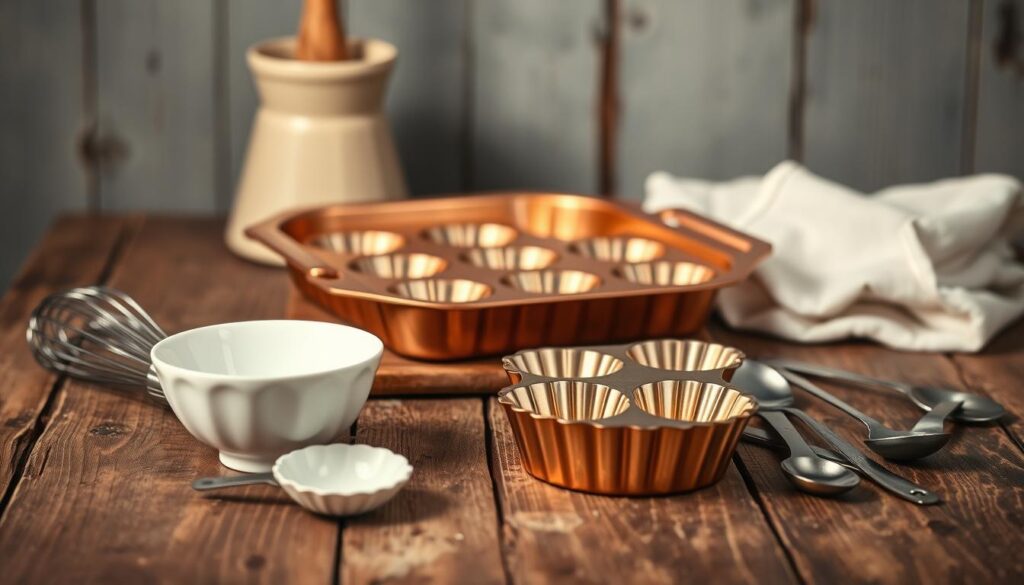
Choosing the Right Madeleine Pan
Your madeleine pan is key. Look for these important features:
- Non-stick metal construction
- Precise shell-shaped molds
- Sturdy material like aluminum or carbon steel
- Preferably with shallow, defined ridges
Essential Baking Tools
You’ll also need several tools for perfect madeleines:
- Whisk or electric mixer
- Silicone spatula
- Measuring cups and spoons
- Small cookie scoop for uniform portioning
- Cooling rack
Pan Preparation Techniques
Proper pan prep is key for easy cookie making. Follow these steps for perfect release:
- Brush pan thoroughly with melted butter
- Chill buttered pan to set
- Dust with flour, tapping out excess
- Refrigerate pan before adding batter
Pro tip: Always grease and flour, even with non-stick pans. It ensures a smooth release and beautiful cookies.
The Art of Brown Butter for Madeleines
Want to make madeleines at home? Mastering brown butter can take your recipe from good to amazing. Brown butter, or beurre noisette in French, brings a rich, nutty flavor that boosts the traditional taste.
Making brown butter needs careful attention and precision. It involves heating butter until the milk solids caramelize. This releases a complex, toasted aroma that makes your madeleines incredibly rich.
- Heat butter slowly in a light-colored pan
- Watch for golden brown color and nutty fragrance
- Remove from heat immediately to prevent burning
- Cool slightly before adding to your madeleine batter
Perfect brown butter requires patience and vigilance. Use a light-colored pan to track the butter’s change. As it melts, it foams, then turns golden, and finally deep amber, signaling peak flavor.
| Butter Stage | Color | Flavor Profile |
|---|---|---|
| Melted | Pale Yellow | Mild Butter Taste |
| Browning | Golden | Nutty Hints |
| Brown Butter | Deep Amber | Rich, Toasted Flavor |
Adding brown butter to your madeleine recipe gives it a sophisticated twist. It will impress both family and friends.
Step-by-Step Madeleine Cookie Recipe
Making the perfect madeleine cookie recipe needs precision and careful steps. These French treats require attention to detail from start to finish. Your journey to mastering easy madeleine cookie instructions starts with understanding the process of making these delightful shell-shaped cookies.
Preparing Your Madeleine Batter
Mixing the batter is a key step in your madeleine cookie recipe. Follow these important steps:
- Separate eggs, keeping yolks and whites distinct
- Whisk sugar and eggs until light and fluffy
- Gently fold in flour and melted butter
- Incorporate vanilla extract for enhanced flavor
Chilling for Perfect Texture
Chilling is a critical step in making authentic madeleines. Your batter needs time to rest and develop its signature texture.
| Chilling Duration | Expected Result |
|---|---|
| 1-2 hours | Good initial set |
| Overnight | Best flavor development |
Baking to Golden Perfection
When you’re ready to bake, follow these easy steps:
- Preheat oven to 375°F (190°C)
- Grease madeleine pan thoroughly
- Fill each shell mold about 3/4 full
- Bake for 10-12 minutes until edges turn golden
- Look for the signature “hump” on each cookie
Pro tip: Watch your madeleines closely during baking. The difference between perfectly golden and overbaked can be just seconds!
Tips for Achieving the Perfect Madeleine Hump
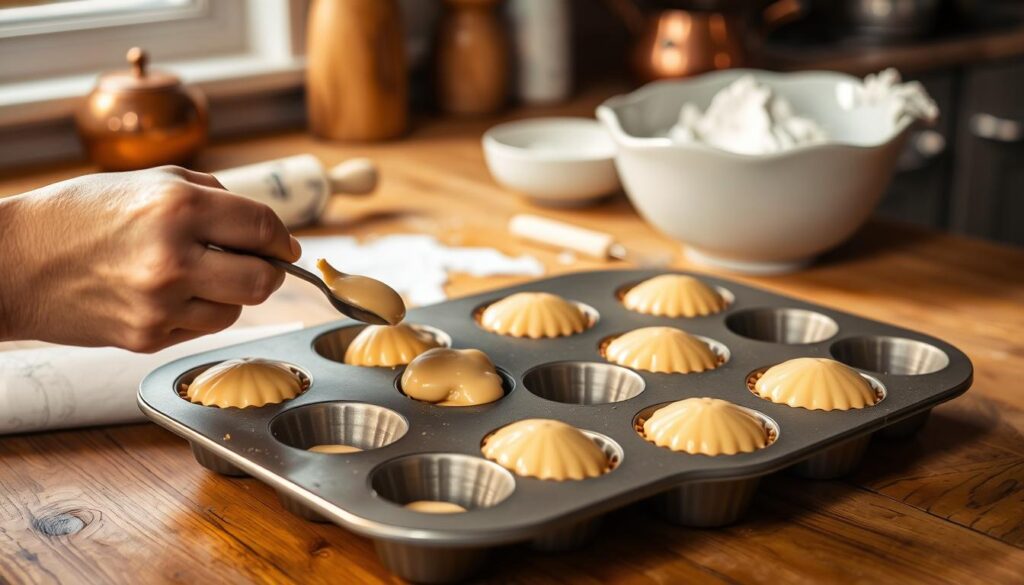
Making the iconic hump is key to great traditional madeleine baking. It shows you’re a true baking artist. The right recipe and techniques are needed to get that perfect rise.
The hump forms through a cool science trick. Cold batter meets hot pans, and magic happens. The quick change in temperature makes the batter rise in the middle, creating the hump.
- Chill your batter for at least 2 hours before baking
- Ensure your madeleine pan is preheated to the right temperature
- Use room temperature eggs for optimal batter consistency
- Avoid overmixing the batter to maintain proper texture
Temperature is key for the hump. Your oven must be just right. Preheat to 375°F (190°C) for the best results. The heat makes the batter rise fast, forming the hump.
Professional bakers share some secrets for success:
- Refrigerate your pan before adding batter
- Use a piping bag for even batter distribution
- Fill madeleine molds only 3/4 full to allow room for rising
Getting the madeleine hump right takes time. Don’t worry if it takes a few tries. Each batch gets you closer to those perfect, golden treats that will wow everyone.
Classic Flavor Variations and Add-ins
Make your homemade madeleine cookie experience exciting by trying new flavors. These small, shell-shaped treats are perfect for creative bakers. They offer endless ways to make your recipes unique.
Classic flavors can make your madeleines stand out. Here are some popular ones:
- Citrus Zest: Lemon and orange zest add a bright, refreshing taste
- Nutty Delights: Almond extract or ground nuts give a rich, complex flavor
- Chocolate Lovers: Cocoa powder or chocolate chips add a sweet treat
- Spice Infusions: Cardamom, cinnamon, or lavender add a sophisticated touch
When adding new flavors, balance is key. Too much liquid can ruin the texture. Make sure dry ingredients are sifted for even mixing.
Try glazes and dustings to make your madeleines even better. A light dusting of powdered sugar, a drizzle of dark chocolate, or a sprinkle of sea salt can elevate them. These touches can turn simple treats into something amazing.
Common Mistakes to Avoid When Baking Madeleines
Even experienced bakers can face challenges when making madeleines at home. To master easy madeleine cookie instructions, it’s important to know the common mistakes. These mistakes can ruin your delicate French treats.
Baking perfect madeleines requires precision and careful technique. Let’s look at the most common mistakes that can ruin your cookie-making process.
Temperature Control Challenges
Temperature is key to making exceptional madeleines. Here are some important tips:
- Chill batter for 30-60 minutes before baking
- Avoid over-chilling, which can solidify butter
- Preheat oven to exactly 350°F (177°C)
*”Precision is the secret ingredient in madeleine baking”*
Mixing and Folding Techniques
The delicate nature of madeleines needs gentle handling:
- Fold dry ingredients gently to preserve egg structure
- Temper melted butter by mixing with a small batter portion
- Avoid overmixing, which deflates the batter
Baking Time Precision
Timing is everything when baking these delicate cookies:
- Bake for 10-12 minutes
- Check doneness by pressing lightly on tops
- Look for a springy, golden surface
Pro tip: Practice makes perfect when you make madeleines at home. Don’t get discouraged by initial attempts!
Decorating and Serving Suggestions
Turning your classic madeleine cookies into stunning desserts is simple. These French pastries are perfect for creative presentation. They will impress your guests and delight their taste buds.
Begin with elegant decoration techniques that show off the cookies’ delicate nature:
- Dust with powdered sugar for a classic French touch
- Drizzle with high-quality melted chocolate
- Create delicate glazes with lemon or vanilla
- Sprinkle with finely chopped nuts or edible flowers
When serving your classic madeleine cookies, keep these presentation tips in mind:
| Occasion | Serving Suggestion |
|---|---|
| Afternoon Tea | Arrange on a tiered silver platter with fresh berries |
| Dinner Party | Serve warm with a chocolate dipping sauce |
| Casual Brunch | Display on a rustic wooden board with espresso |
Temperature is key when serving French pastry madeleine treats. Always serve them slightly warm or at room temperature to maximize their delicate texture and rich flavor. Pair with drinks like Earl Grey tea, espresso, or a light dessert wine for a memorable experience.
“The beauty of madeleines lies not just in their taste, but in their elegant presentation.” – French Pastry Chef
Storage and Freshness Tips
Making the best madeleine recipe is not just about baking. It’s also about keeping them fresh. Your homemade madeleine cookies need the right storage to stay delicious and soft.
Room Temperature Storage
For short-term storage, follow these tips:
- Use an airtight glass container
- Place a paper towel at the bottom to absorb moisture
- Add a few sugar cubes to prevent excessive dryness
- Store at room temperature for 2-3 days
Freezing Techniques
To keep your madeleines fresh longer, freeze them:
- Cool madeleines completely before freezing
- Wrap each cookie individually in plastic wrap
- Store in a freezer-safe container
- Freeze for up to three months
Refreshing Techniques
To make stale madeleines fresh again, try these:
- Sprinkle with milk or water
- Warm in oven at 300°F for 5 minutes
- Restore original soft texture
| Storage Method | Duration | Texture Preservation |
|---|---|---|
| Room Temperature | 2-3 days | Good |
| Freezer | 3 months | Excellent |
| Refrigerator | 5-7 days | Fair |
Pro tip: Always let frozen madeleines thaw at room temperature for the best taste and texture.
Pairing Madeleines: Beverages and Accompaniments
Enhancing your madeleine baking is more than just the recipe. Pairing these French cookies can turn your baking into a fancy tasting adventure.
Your madeleine recipe needs the right match. French tradition has many classic pairings that bring out the cookie’s flavor.
Classic French Beverage Pairings
- Café au Lait: A creamy French coffee that complements the buttery texture
- Earl Grey Tea: Bergamot notes beautifully match the subtle sweetness
- Herbal Tisanes: Light, aromatic infusions that cleanse the palate
Modern Serving Suggestions
Today’s chefs have added new twists to madeleine baking. Try these modern pairings:
- Chocolate ganache for dipping
- Fruit compotes as a side accompaniment
- Sparkling wine for an elegant twist
Try different flavors to find your favorite madeleine experience. Whether you like old-school or new ideas, these pairings will make your madeleines a gourmet treat.
Conclusion
Making madeleines at home needs patience, precision, and passion. Your journey starts with learning the fine techniques that turn simple ingredients into beautiful treats. Focus on chilling, mixing, and baking carefully to make restaurant-quality madeleines at home.
The madeleine cookie recipe is a culinary adventure that connects you to French baking traditions. Each batch is a chance to improve your skills. Whether you stick to vanilla or try new flavors, your hard work will show in every cookie.
As you keep making madeleines, you’ll get better at balancing technique and creativity. Enjoy the learning, share your creations, and dive into the rich culture of French baking. Your kitchen is now a doorway to a world of delicious exploration.
With practice and passion, you’ll go from a beginner to a madeleine expert. You’ll make unforgettable memories with each perfectly baked cookie.
FAQ
What are madeleines?
Do I need a special pan to make madeleines?
Why is chilling the batter important?
Can I make madeleines without brown butter?
How long do madeleines stay fresh?
What are some classic madeleine flavor variations?
Why didn’t my madeleines develop a hump?
Are madeleines difficult to make?
What should I serve with madeleines?
Can I make madeleines gluten-free?
Leave a review :
There are no reviews yet. Be the first one to write one.
Leave a review :
There are no reviews yet. Be the first one to write one.

